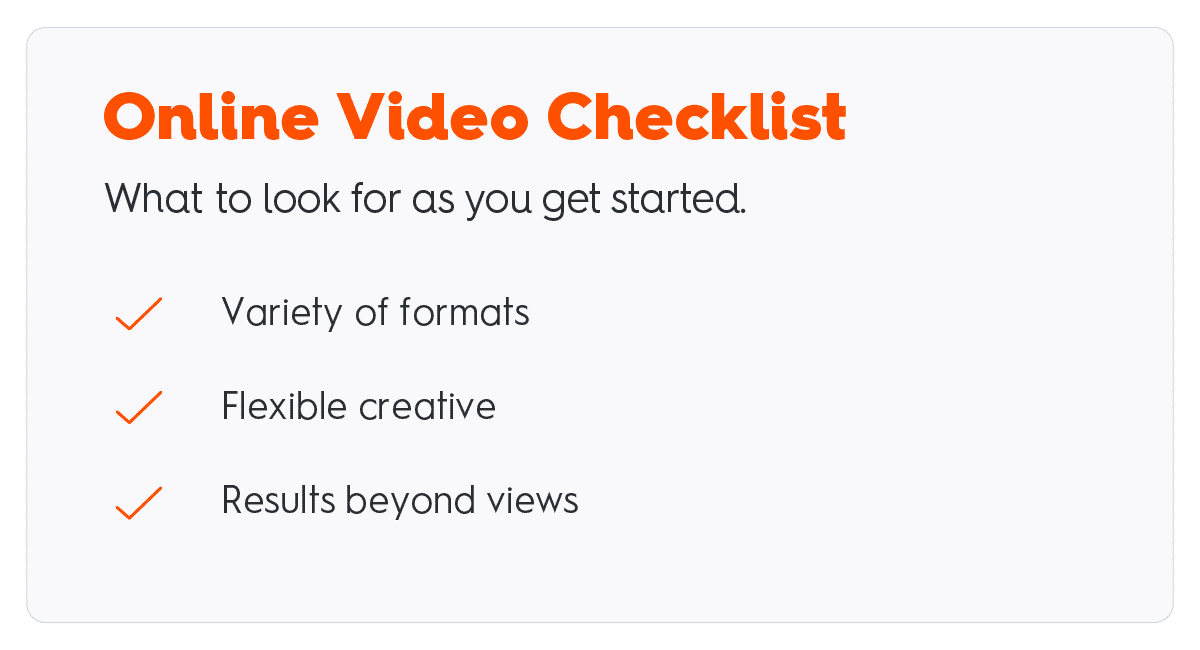Amidst all the talk about what the future of advertising will look like beyond 2023, one thing has become clear: The digital advertising winners will be those who can create a new, responsible approach to addressability. Addressable advertising relies on identifiers to improve the planning, engagement, measurement, and optimization of digital advertising. For example, when you can identify what stage a consumer is in their customer journey and target them with the right message on the right channel, you can improve the effectiveness of ad campaigns. To date, most addressable audiences have been built using third-party cookies as a proxy for identity.
The challenge now is to build and reach scalable, addressable audiences via other methods. There are a variety of ways to do this, including matched first-party data, universal IDs, and browser-based audiences. But for now, these each come with their challenges and open questions.
That’s why it’s crucial for advertisers to test alternative solutions while third-party cookies are still available. Those that focus now on building up their own first-party data pool and on finding effective ways to build and activate addressable audiences will be in a much better place come 2023.
With their large, engaged audiences, access to first-party data, and in the case of contextual targeting, an approach which doesn’t rely on cookies–these three campaigns are a great place to start.
1: Online Video Advertising (OLV)
Online video, OLV for short, is a blanket term for all kinds of digital video. Examples include video streaming services (paid ones like Netflix and Disney+, and free ones like Pluto TV and Crackle), videos on social media, and on-demand videos on publisher sites and apps. Online video ads outside of CTV and OTT environments include in-stream (within video content) and outstream (outside of video players) on the web, mobile web, and mobile apps.
Online video has reached peak popularity among consumers. But that’s not the only factor driving marketers to invest in video advertising: Video is also becoming one of the most important touchpoints throughout the customer journey.
Today, people are consuming all types of video content with a buying mindset, and they’re purchasing further up the funnel as they’re just discovering a brand. In fact, findings from our recent survey showed that video ads prompted more than half of viewers to research the product or service in the ad, 52% to visit the advertiser’s website, and 45% to purchase the product.1
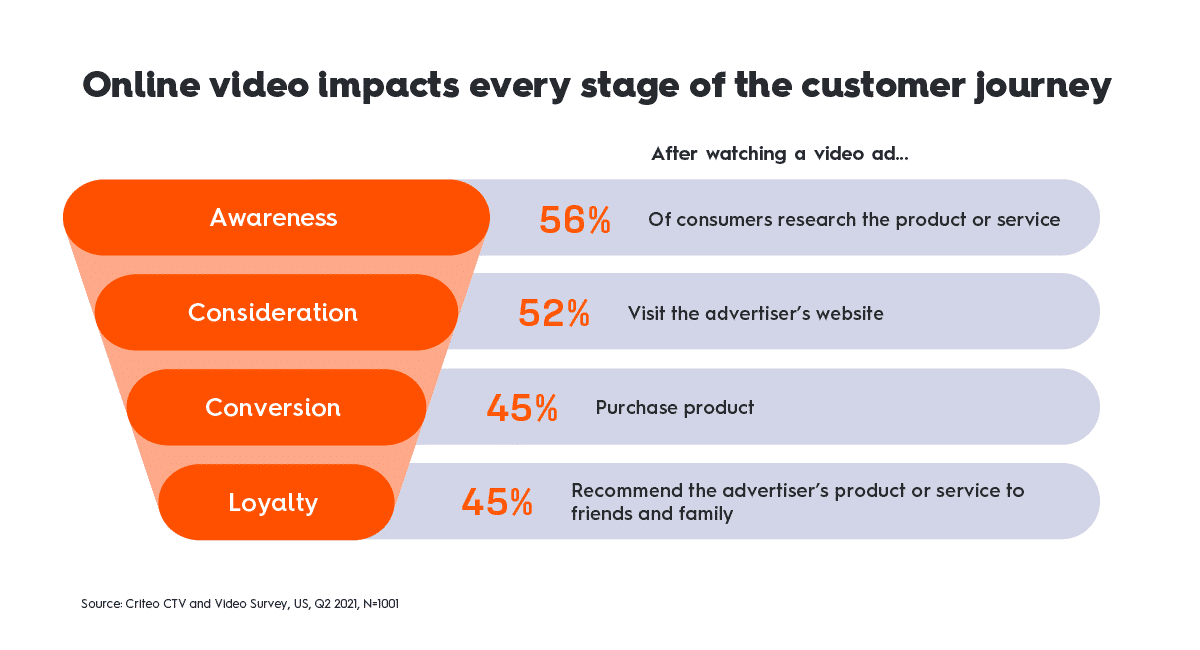
Based on this data and thanks to new features and full-funnel measurement capabilities, advertisers are now seeing online video (OLV) advertising as a performance solution as well as a brand awareness play. As consumers experience digital fatigue and their attention spans become even shorter, video ads can capture their attention across every channel and device they use and drive them through the path to purchase.
OLV Benefits
Beyond the obvious benefit of reaching audiences with a highly engaging format where they’re spending an increasing amount of time, OLV ads have other advantages for advertisers:
Proof of impact: Full-funnel solutions that combine OLV with display and retargeting enable advertisers to connect results directly to their business goals, such as conversions, sales, or ROAS (unlike broad-based TV and out-of-home campaigns).
Diversified spend: Video inventory across desktop and app and throughout the open internet strengthens the marketing mix and gives advertisers a measurable, scalable alternative to the walled gardens.
Omnichannel strategy: The right video partner can help advertisers connect their video campaigns with other consideration and conversion campaigns to deliver a cohesive experience.
Online Video (OLV) Checklist
Here’s what to look for as you get started with OLV:
- Variety of inventory and formats: Find a video advertising solution that gives you access to a wide range of inventory sources through direct relationships with premium publishers and video streaming services, as well as the ability to leverage in-stream, outstream, and interstitial for app to maximize video views.
- Flexible creative: Beyond awareness, make sure your video advertising partner has creative formats that combine clips of your video with display ad elements to drive lower-funnel objectives like consideration, conversion, and repeat purchases.
- Results beyond views: Make sure you can understand the impact your videos have on downstream advertising efforts and be able to connect a video view through to a sale.
To learn more about OLV campaigns, contact us.
2: Connected TV (CTV)/OTT
A very hot subset of online video is connected TV. Connected TV is ads served within shows and movies that are streamed via over-the-top (OTT) services on any connected TV (televisions with a built-in internet connection) or streaming device (like Apple TV, Amazon Firestick, or Roku). OTT is any video content “over the top of a cable box”. It is an umbrella term that includes both CTV and OLV advertising, and includes services such as Netflix, Hulu, and Sling.
This year, 30% of the world’s population will use OTT video according to the Statista Market Forecast. In countries like Australia, Canada, Germany, Italy, the UK, and the US, user penetration is much higher at more than 70%.2
Smart marketers are eyeing these growing streaming audiences and investing in connected TV advertising.
CTV/OTT Benefits
Perhaps one of the biggest benefits of CTV/OTT advertising is its addressability (more on that in a second), but there are also other advantages to testing CTV:
Addressable: Many streaming video services require a login with an email address, which enables advertisers to use the streaming services’ first-party data to safely target audiences. Our State of Video and Connected TV Survey also showed that 4 out of 5 Americans use the same email ID to access video streaming services and shop online.1 This means that marketers can connect video viewing with shopping behaviors across devices and channels using privacy-safe hashed email addresses.
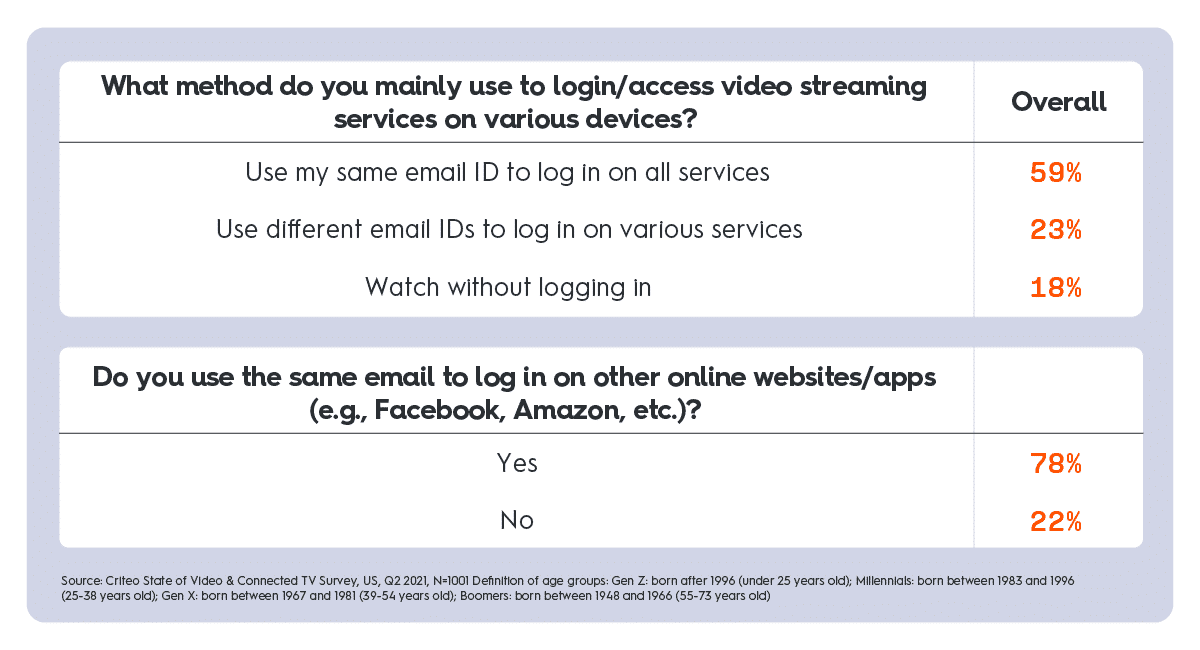
Diversified Spend: Reach targeted audiences on a new channel where viewers are hyper-engaged. Plus, reach cord-cutters and cord-nevers (those who don’t see traditional TV commercials).
Brand Safety: Minimize the risk to your brand reputation with ads that appear with high-quality streaming content from top TV networks and movie studios.
Connected TV Checklist
Here’s what to look for as you get started with CTV:
- Large CTV and OTT inventory: Find a partner with a large footprint and access to major supply-side partners (SSPs) to reach audiences where they’re already consuming video content. Ask what devices (smart TVs, internet-connected devices, etc.) and services (authenticated apps, SVODs, etc.) that partner works with directly, as well as the exchanges they work with. This allows you to reach consumers regardless of their streaming preferences.
- Precise audience targeting: Make sure you can use first-party data from CTV devices and streaming services combined with your own and your advertising partner’s first-party data to target audiences that have the highest likelihood to engage or buy your products and services.
- Full-funnel management: Use one partner for your connected TV, video, and display ad campaigns to see the impact of connected TV ads on lower-funnel outcomes. This will also enable advertisers to scale their video creative and get the most return on their creative investment. One great video creative can drive brand awareness across streaming devices, OTT services, desktop, mobile web, and in-app.
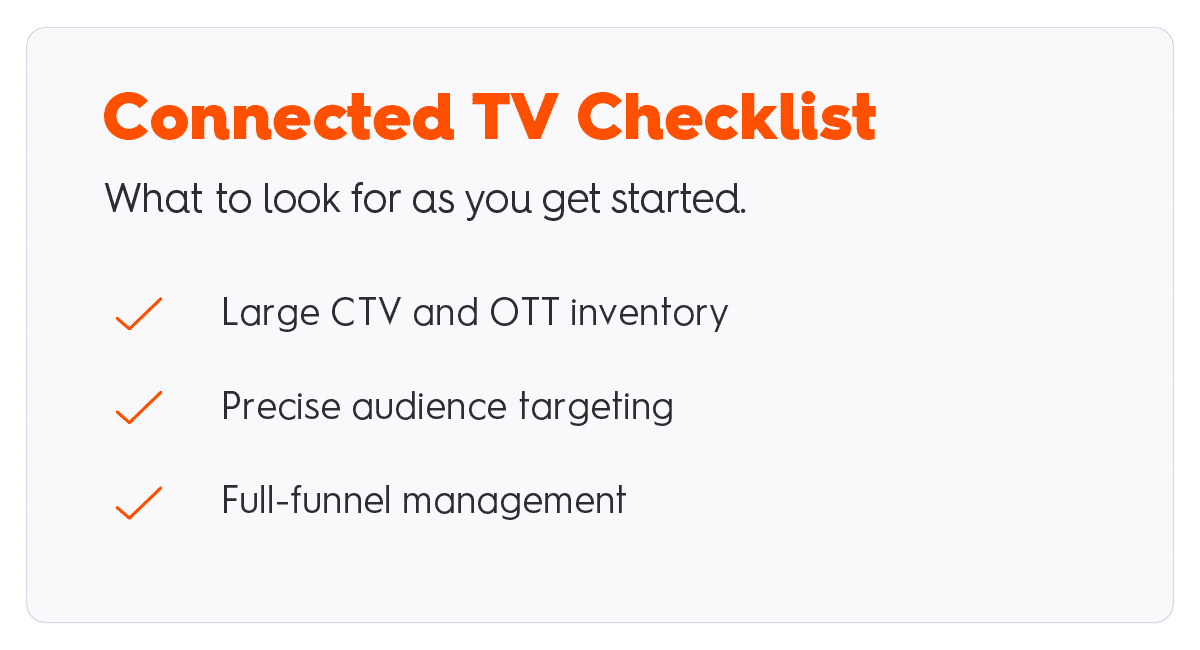
To learn more about CTV campaigns, contact us.
3: Contextual Targeting
Contextual targeting has been around for decades, but it’s back in the spotlight because it serves as an effective solution for engaging consumers online with digital advertising. This type of targeting matches an ad to a website page based on the content of that page. The focus is on the content being consumed—not who is consuming it, which means it doesn’t rely on identifiers in any way. Marketers are eager to revisit the possibilities of contextual targeting as a way to reach audiences both today and in the future.
To build contextual campaigns that deliver results comparable to today’s cookie-based advertising, the industry is going beyond traditional keyword targeting. By marrying first-party data with contextual signals, a new and improved kind of contextual targeting has evolved to help reach consumers who are in a buying mindset. Here’s how:
Next-Gen Contextual Targeting Benefits
Today’s contextual targeting is far more sophisticated than it used to be. Technological advancements have made it much smarter and more precise. Here are the benefits that have marketers giving contextual targeting another look:
Machine Learning: Machine learning and natural language processing (NLP) are helping advertisers move away from keywords and inclusion lists and rely on AI instead to find the most relevant content, opening opportunities for their campaigns to get more reach. Rather than exclude an entire content category, AI can understand the sentiment of every webpage and infer where your ads should or should not be placed. In addition to text analysis, machine learning can scan images, video, and audio and understand their meaning. This adds to the overall understanding of a webpage and gives advertisers other inventory options, like video, connected TV (CTV) and OTT ads.
Commerce Signals: Criteo’s contextual targeting solution is the first of its kind to analyze an advertiser’s first-party data on recent transactions and uncover what webpages and contextual categories preceded those transactions. These are commerce signals. They can be married with contextual signals to identify the media most likely to perform and to identify the best products to advertise on each webpage.
Media Lookalikes: Criteo’s contextual targeting solution uses first-party data to create affinity scores between products in an advertiser’s catalogue and publisher domains and categories to identify and target the media most likely to drive results.
Brand Safety: With sophisticated technology comes built-in brand safety. When machine learning analyzes every element of a webpage, it ensures that ads only appear next to relevant content and avoids inappropriate content. This opens up even more ad inventory and campaign reach while giving advertisers peace of mind.
Privacy: Because contextual doesn’t target specific users, it doesn’t rely on third-party cookies in any way.
Contextual Targeting Checklist
Here’s what to look for as you get started with contextual targeting:
- First-party data enhancements: Choose a solution that uses your first-party data to better understand the content interests of your audiences and refine contextual targeting.
- Publisher relationships: Work with a partner that has enough publisher relationships to provide reach and scale for your campaigns.
- Sophisticated tech: Use a solution that leverages machine learning and NLP to get a deeper understanding of the context and sentiment of each page. This includes scanning text, images, and even video and audio to understand the full context of a webpage.
- Brand safety: Extend the reach of your campaigns by using machine learning to avoid inappropriate content.
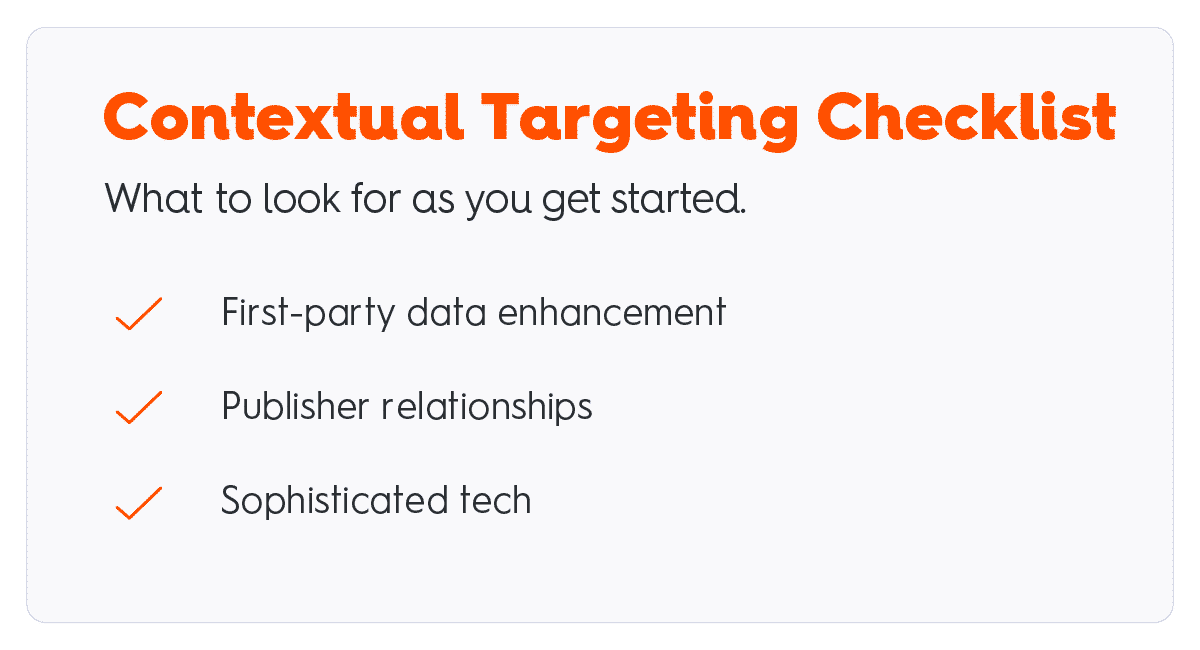
To learn more about contextual targeting campaigns, contact us.
Want more digital advertising advice? Download our latest Shopper Story 2022 report on consumer trends and advertising strategies:
1 Source: Criteo State of Video and Connected TV Survey, US, Q2 2021, n=1001
2 Statista Market Forecast, OTT Video, Worldwide (Forecast adjusted for expected impact of COVID-19)







